A Picture is Worth a Thousand Words
Stained glass has been an amazing art form since ancient times. As early as the 7th century, craftsmen began including stained-glass windows in Catholic churches. Since the vast majority of the population was illiterate, the windows included details from stories in the Bible. Imagine the truth and beauty of hearing the Scripture readings at Mass and then looking up at a window depicting the story as the sunlight streams through as if to highlight the listener’s understanding. Perhaps while praying the rosary, one could gaze upward to a window featuring one of the mysteries. Stained-glass windows in churches serve many beautiful purposes! Our parish is blessed with several wonderful stained-glass windows depicting many aspects of the Eucharist.
West Side of the Church
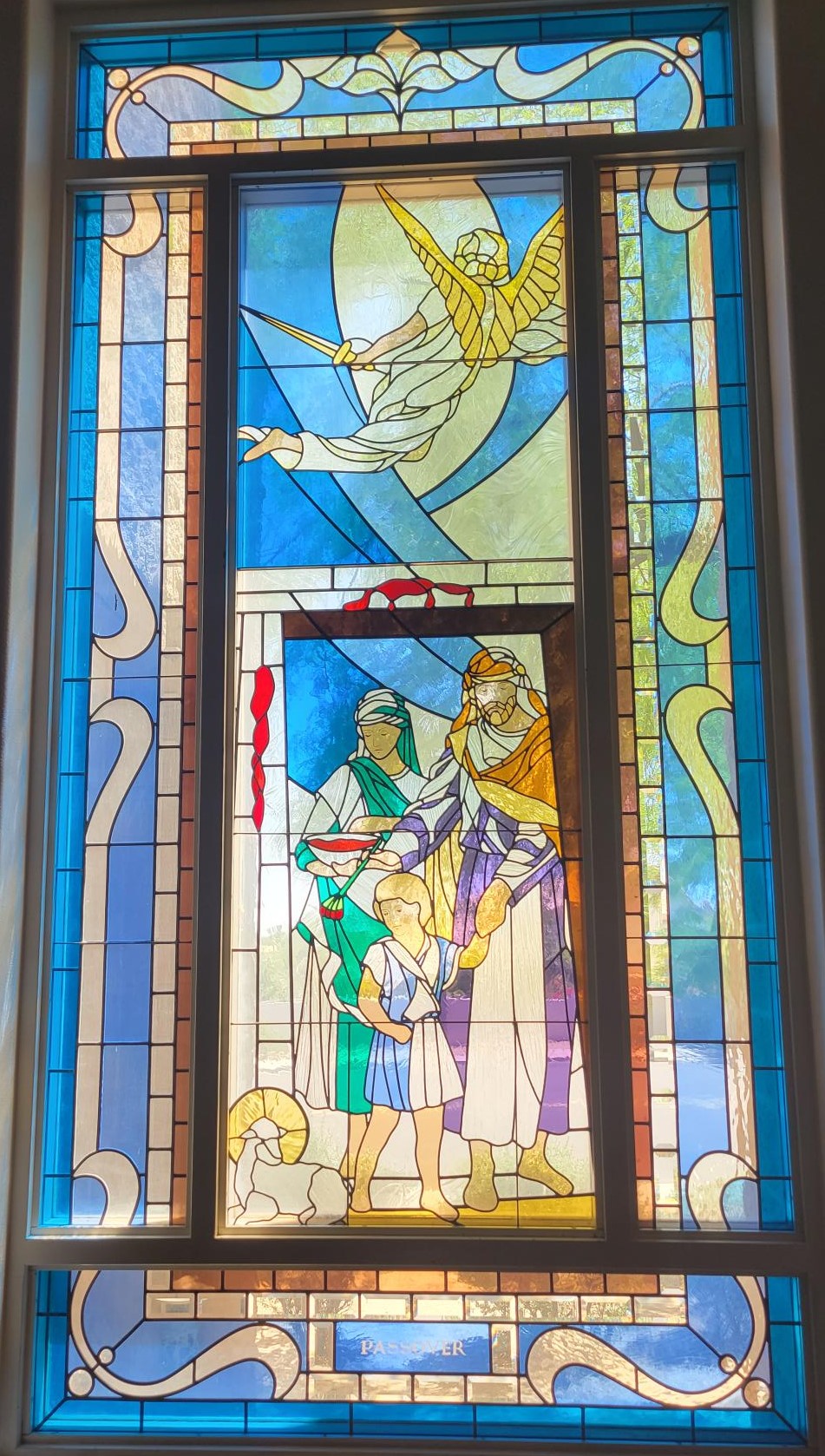
Passover
Passover [the English noun is derived from the Hebrew, Pesach, (Exodus 12:13)] refers to the religious celebration that commemorates God’s deliverance of the Israelites from slavery in Egypt. The feast was celebrated by the family in their home during the night (specifically, during the full moon of the vernal equinox) on the 14th day of the month of Nisan (typically in April). A young lamb, born that year with neither blemish, nor broken bones (Ex 12:46, Num 9:12) would be slain (Ex 12:13-6) and its blood placed on the door frame and overhead lintel of each household, thus preserving the firstborn son from the angel of death (Ex 12:7, 22). The lamb’s flesh and the unleavened bread were eaten in a manner reflecting a people rushed and about to leave on a journey.
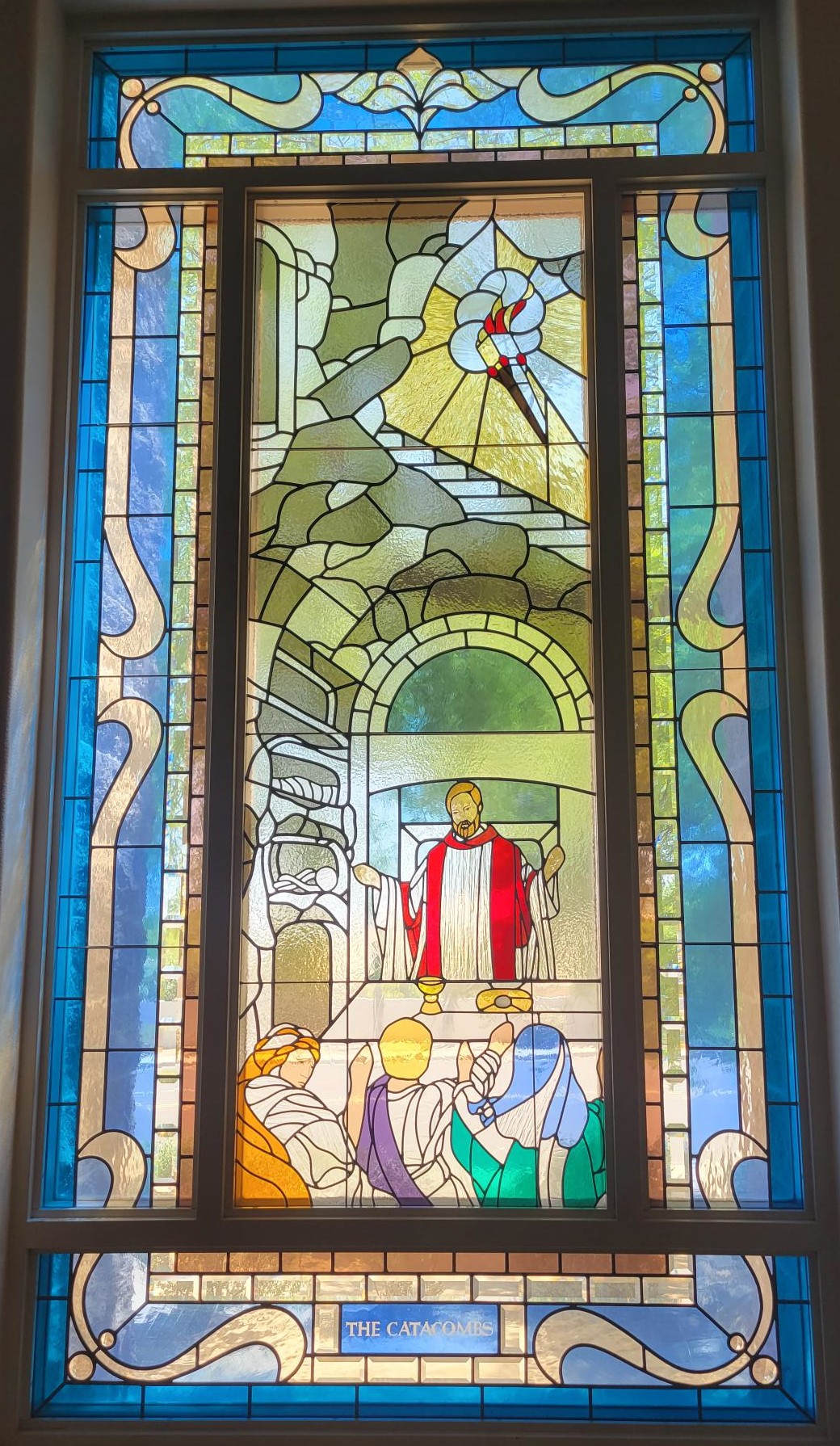
Catacombs
The word catacomb is derived from an early descriptive name of the cemetery of St. Sebastian in Rome. The Latin expression, ad catacumbas, probably meant “near the hollows.” One of the most iconic features of a catacomb is the network of galleries in which the walls once offered ample room for creating niches to place the bodies of the dead. Indeed, judging from the catacombs that have been preserved, this type of burial area seemed to have been used principally by Christians. The presence of the bodies of martyrs in certain catacombs led to extensive renovations, which sometimes involved the creation of an underground sacred area for veneration around the martyrs’ tombs. It is believed that during the very early years of the Church, when Christians were not allowed to practice their faith publicly, they gathered to celebrate the Mass secretly in the catacombs, where their persecutors were less likely to look for them.
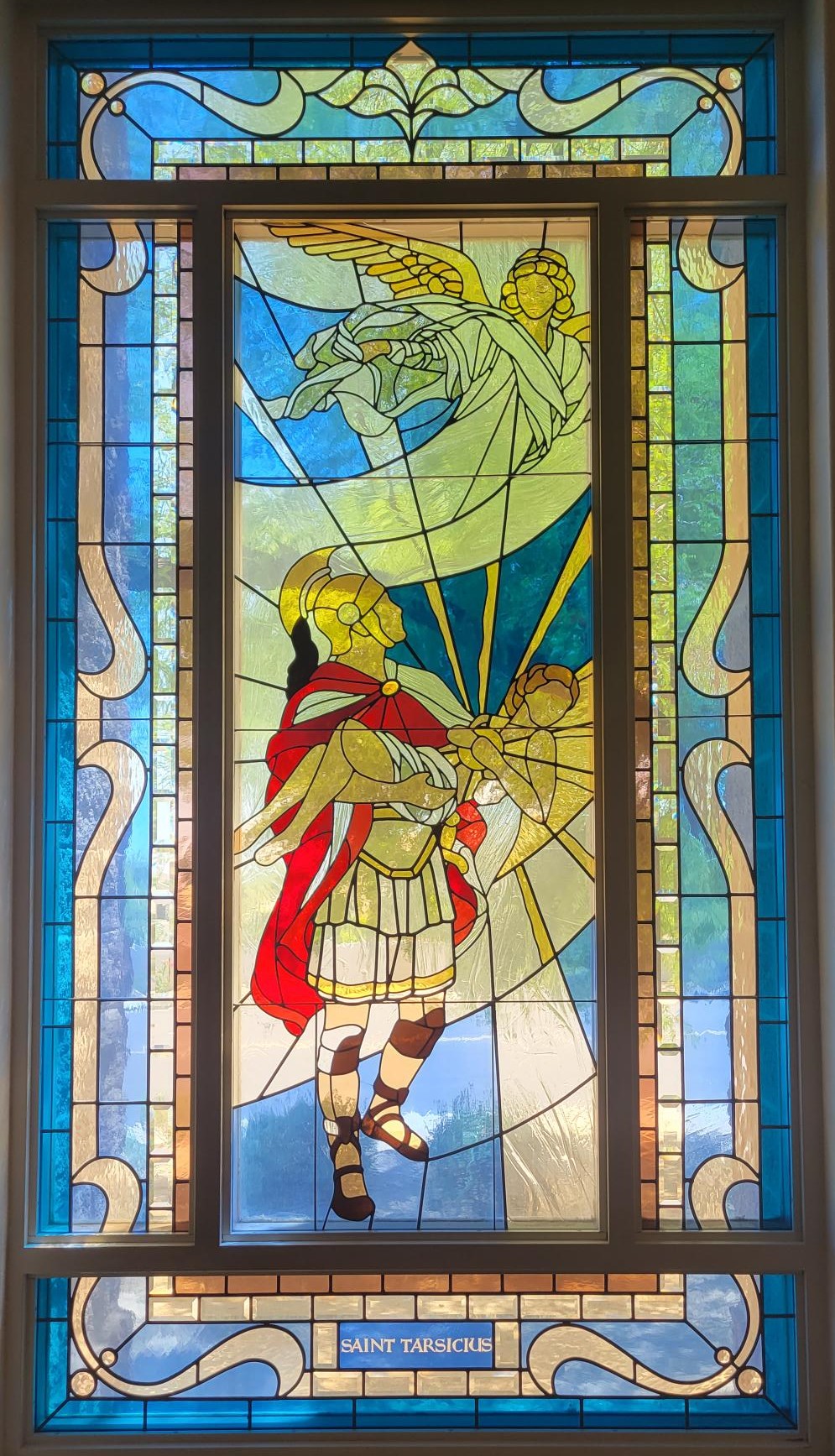
Saint Tarsicius
Tarsicius was a boy in 3rd century AD Rome. During the great reign of Emperor Valerian, many Christians were persecuted, thrown into prison, and often martyred. As an altar server, and hopefully not noticeable by those who hunted Christians, Tarsicius was tasked with taking the Eucharist to Christians in prison. On his journey, he held the small package in his tunic, next to his heart. A mob of pagans, curious about what he was hiding, beat him, stoned him, kicked him, and tried to pry his hands from his chest to obtain what he was holding. Determined to prevent them from discovering and desecrating the hosts, he protected the Blessed Sacrament with his life. Just before he died, a soldier (secretly a Christian) scattered the crowd and scooped up Tarsicius into his arms. With his last breath, Tarsicius asked the soldier to take Jesus to the Christians in prison. “The Boy Martyr of the Holy Eucharist” is the patron saint of altar servers and first communicants.

Latin Mass
Latin has been the official language of the Catholic Church since around the 4th century. St. Jerome provided a translation of the Bible from Greek to Latin, the common language of Rome at the time. The Mass was celebrated in Latin around the world until the changes following the Second Vatican Council. Although use of the Latin language has decreased significantly over time, as Christianity spread, hearing Mass in Latin was a unifying aspect of Catholics everywhere. Additionally, a most notable difference at the Latin Mass is that the priest faces the same direction as the people, leading them in prayer “ad orientum,” Latin for “to the east,” which is the direction from which Jesus will return.
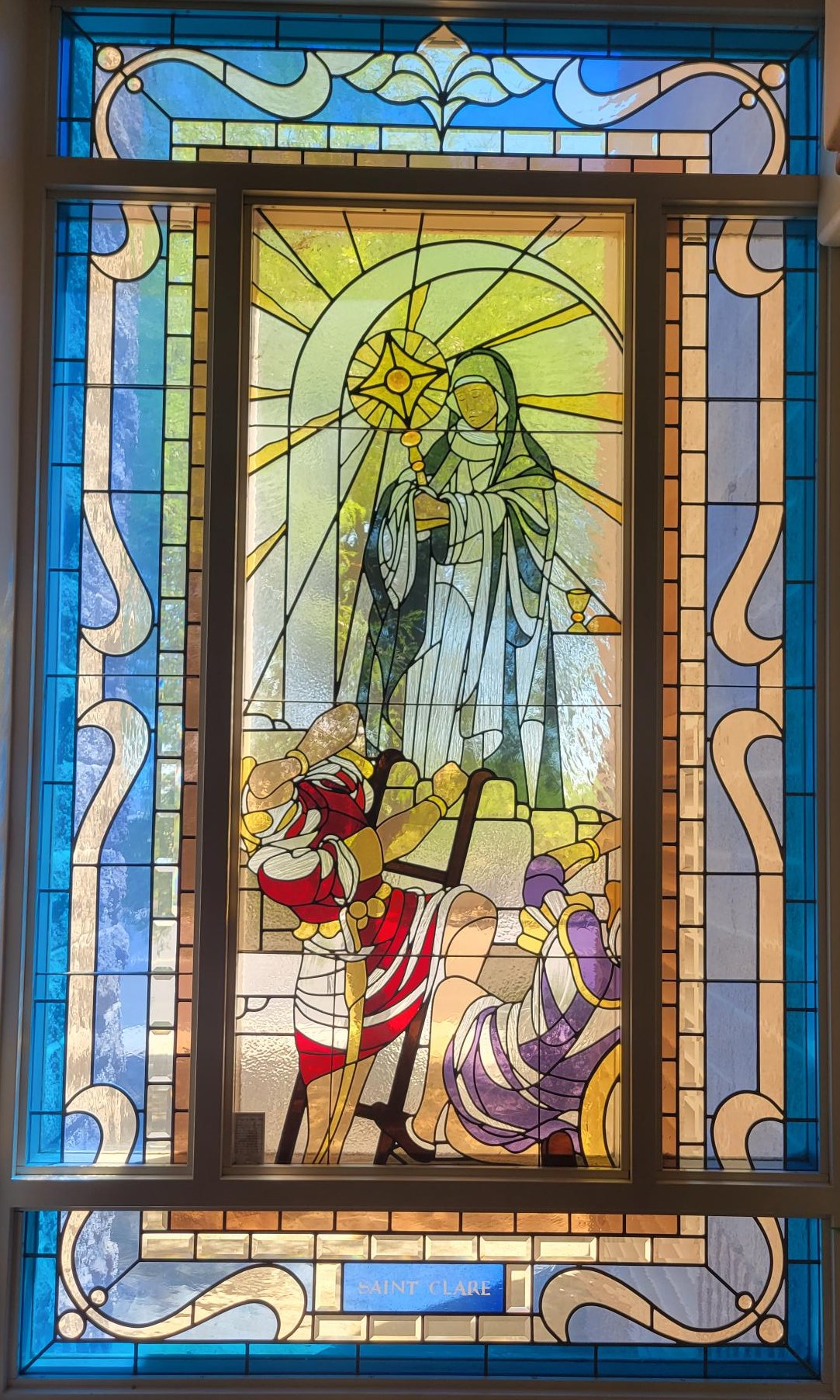
Saint Clare
Another famous Eucharistic miracle is depicted in this window of St. Clare of Assisi. The History of Saint Clare, Virgin, written by Tommaso da Celano, describes how St. Clare of Assisi succeeded, with the Blessed Sacrament, in turning away Saracen troops employed by Emperor Frederick II of Sweden. The website, therealpresence.org, gives a brief description of the story:
Once, during an enemy attack against Assisi… while the army was approaching the gates, the fierce Saracens invaded San Damiano, entered the confines of the monastery and even the very cloister of the virgins. The women swooned in terror, their voices trembling with fear as they cried to their Mother, Saint Clare. With a fearless heart, [she] commanded them to lead her, sick as she was, to the enemy, preceded by a silver and ivory case in which the Body of the Saint of saints was kept with great devotion… [She beseeched the Lord in prayer and then announced to her sisters,] “…only have faith in Christ.” Upon seeing the courage of the sisters, the Saracens took flight and fled back over the walls they had scaled, unnerved by the strength of she who prayed.
Upper North Transom

The Lord's Supper
As though it’s reflecting the celebration of the holy sacrifice of the Mass, the window above the wall leading to the narthex depicts the Last Supper, when Jesus gave us His very Body and Blood as the Eucharist and His Real Presence for all eternity. There are so many beautiful details in this window, including the apostles with their heads bowed in prayer, the landscape, and the little white lamb.
East Side of the Church
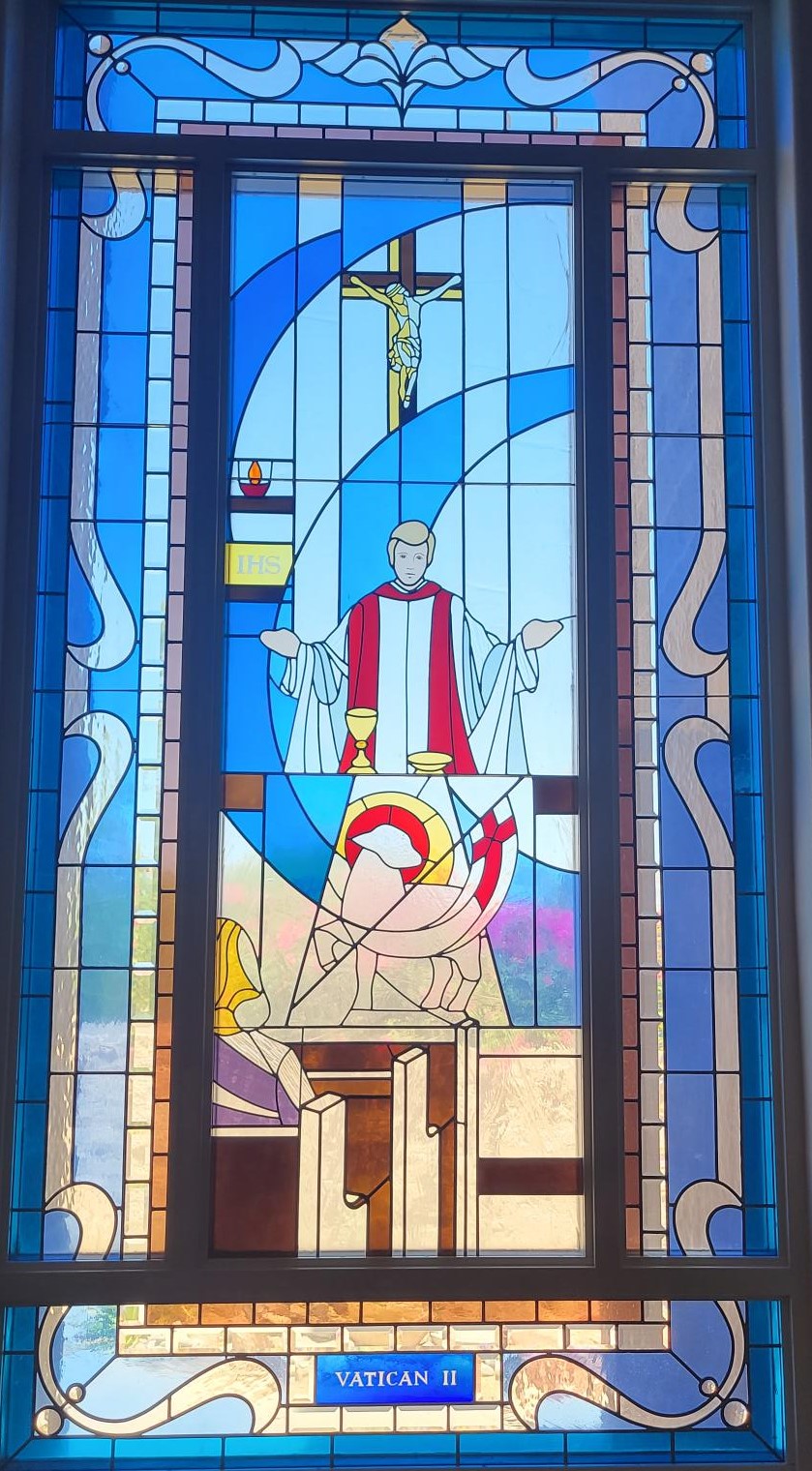
Vatican II
The Second Vatican Council produced several documents that changed the way the faithful experience the Mass. One of these documents, the Constitution on the Sacred Liturgy (Sacrosanctum Concilium) laid out the reform and practical norms of the Liturgy with the goal of greater understanding and participation from the laity.
The Church, therefore, earnestly desires that Christ's faithful, when present at this mystery of faith, should not be there as strangers or silent spectators; on the contrary, through a good understanding of the rites and prayers they should take part in the sacred action conscious of what they are doing, with devotion and full collaboration. They should be instructed by God's word and be nourished at the table of the Lord's body; they should give thanks to God; by offering the Immaculate Victim, not only through the hands of the priest, but also with him, they should learn also to offer themselves; through Christ the Mediator, they should be drawn day by day into ever more perfect union with God and with each other, so that finally God may be all in all. [48]
After the Council, one significant change at many parishes was that the priest faced the people during Mass, similar to being gathered around the table for the Last Supper.

Pope Saint Pius X
From the late Middle Ages until the early 20th century, conditions, and expectations of sacramental preparation in the Roman Catholic Church had changed to the extent that eventually, only adults were allowed to receive Holy Communion. In 1910, Pope St. Pius X changed that with his encyclical, Quam Singulari, which decreed, “… the age of discretion, both for Confession and for Holy Communion, is the time when a child begins to reason, that is about the seventh year, more or less.” [QS 21:1] Citing the practices of the early Church, as well as Jesus’ love of children, he restored the baptismal right of children receiving their First Holy Communion and Confession early on in life. Hence, this window shows children gathered around Pope Saint Pius X.
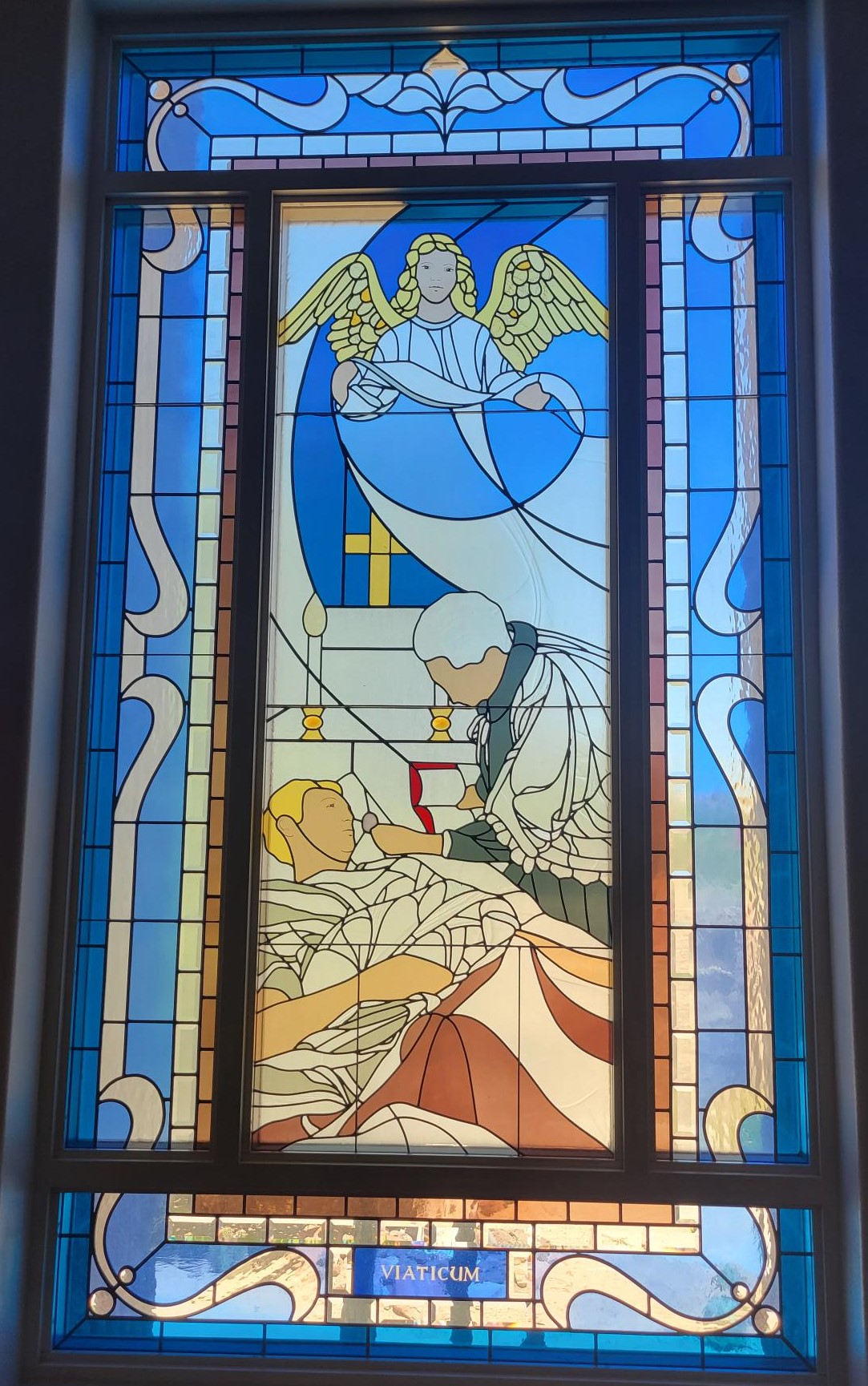
Viaticum
This Latin word is commonly understood as provisions for a journey. Receiving Holy Eucharist prior to death is receiving the Bread of Life for the journey to eternity. According to the Rites of the Anointing and Viaticum:
The celebration of the Eucharist as Viaticum, food for the passage through death to eternal life, is the sacrament proper to the dying Christian. It is the completion and crown of the Christian life on this earth, signifying that the Christian follows the Lord to eternal glory and the banquet of the heavenly kingdom. [Ch 5, para 175]
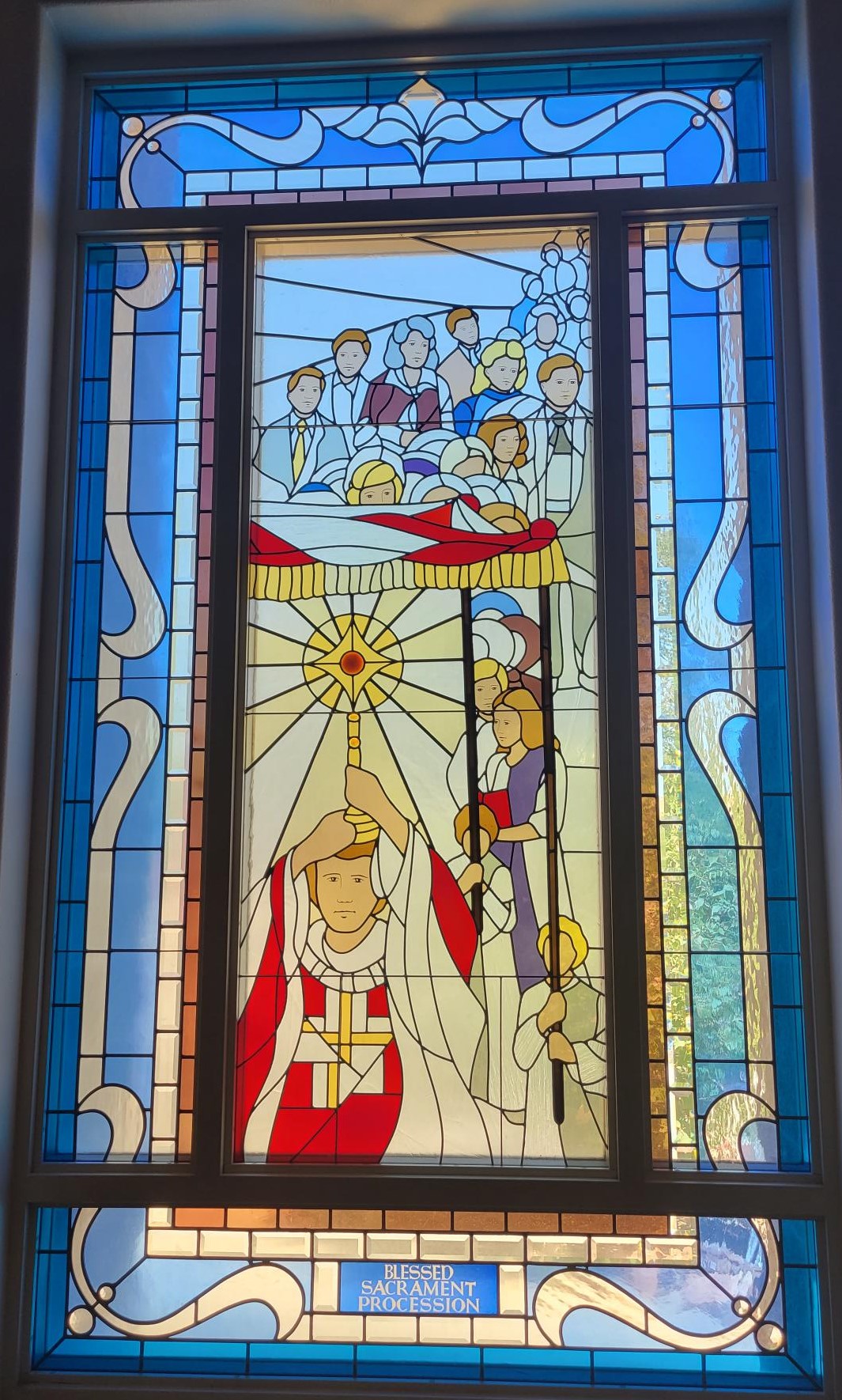
Blessed Sacrament Procession
We follow a long tradition of Eucharistic processions when we celebrate our feast day or other significant events in the Church. In 1551, the Council of Trent declared:
… that this sublime and venerable Sacrament be, with special veneration and solemnity, celebrated, every year, on a certain day, and that a festival; and that it be borne reverently and with honour in processions through the streets, and public places…” [Session XIII, Ch V].
Displaying our faith in the Eucharistic Lord through processions encourages us in our own journey of faith and allows us to share His presence with others.
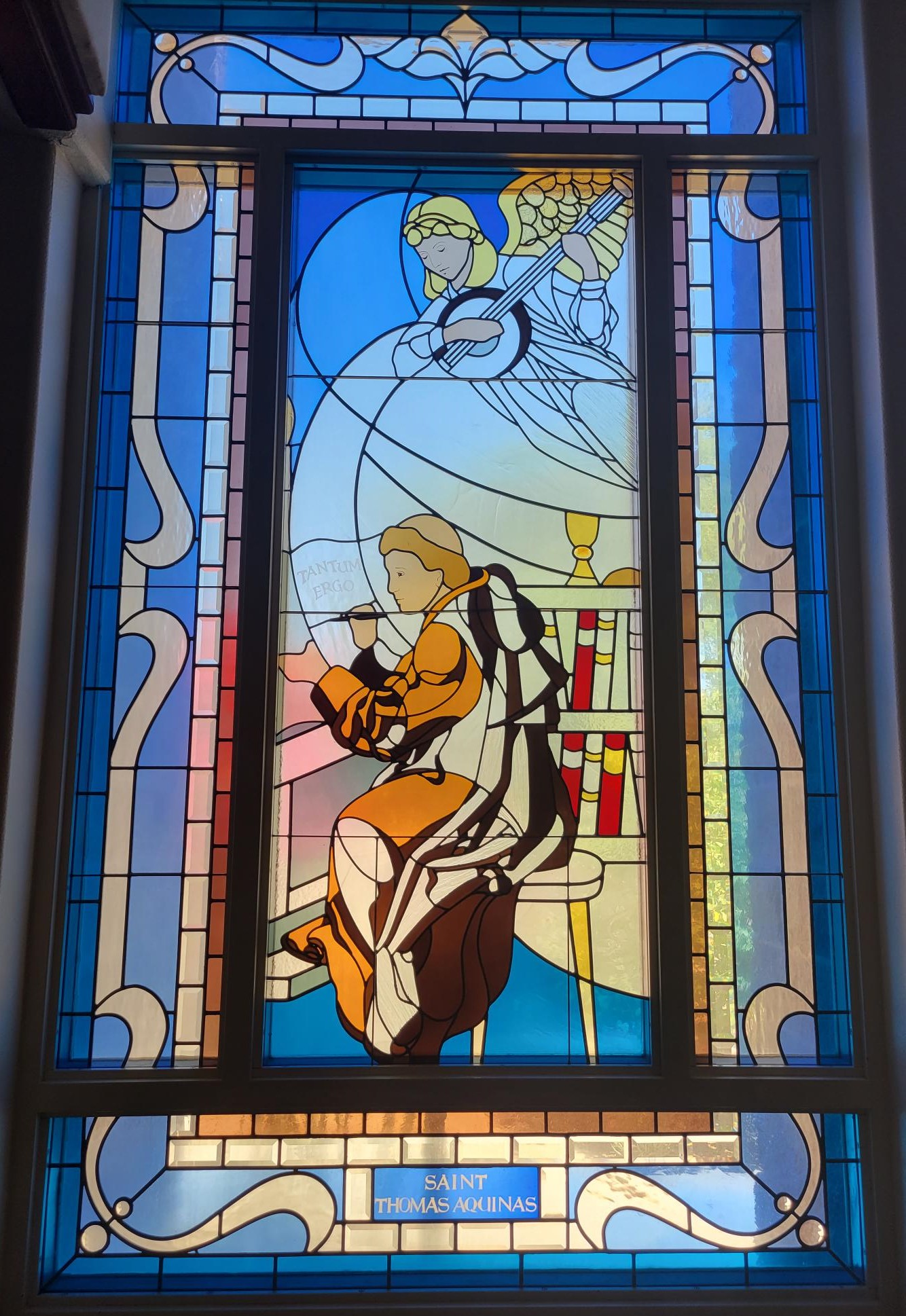
Saint Thomas Aquinas
What can we say about the “Angelic Doctor of the Church” in this small space? An outstanding scholar and philosopher of the Middle Ages, St. Thomas Aquinas spent years writing, teaching, and preaching as a Dominican priest. Even then, great thinkers of the day were wrestling with the relationship between faith and reason. While he wrote more than 60 works, he is best known for his Summa Theologica. As mentioned two weeks ago in the article on the history of our feast day, he composed the verses of Tantum Ergo, which we still sing during Eucharistic exposition. This influential saint will remain a significant source of spiritual nourishment for years to come.
Adoration Chapel of the Most Blessed Sacrament
Our adoration chapel – the heart of our parish – is where we can spend time with Jesus, who loves us more than we can imagine. The stained-glass windows here are beautiful reminders of His ultimate expression of love.
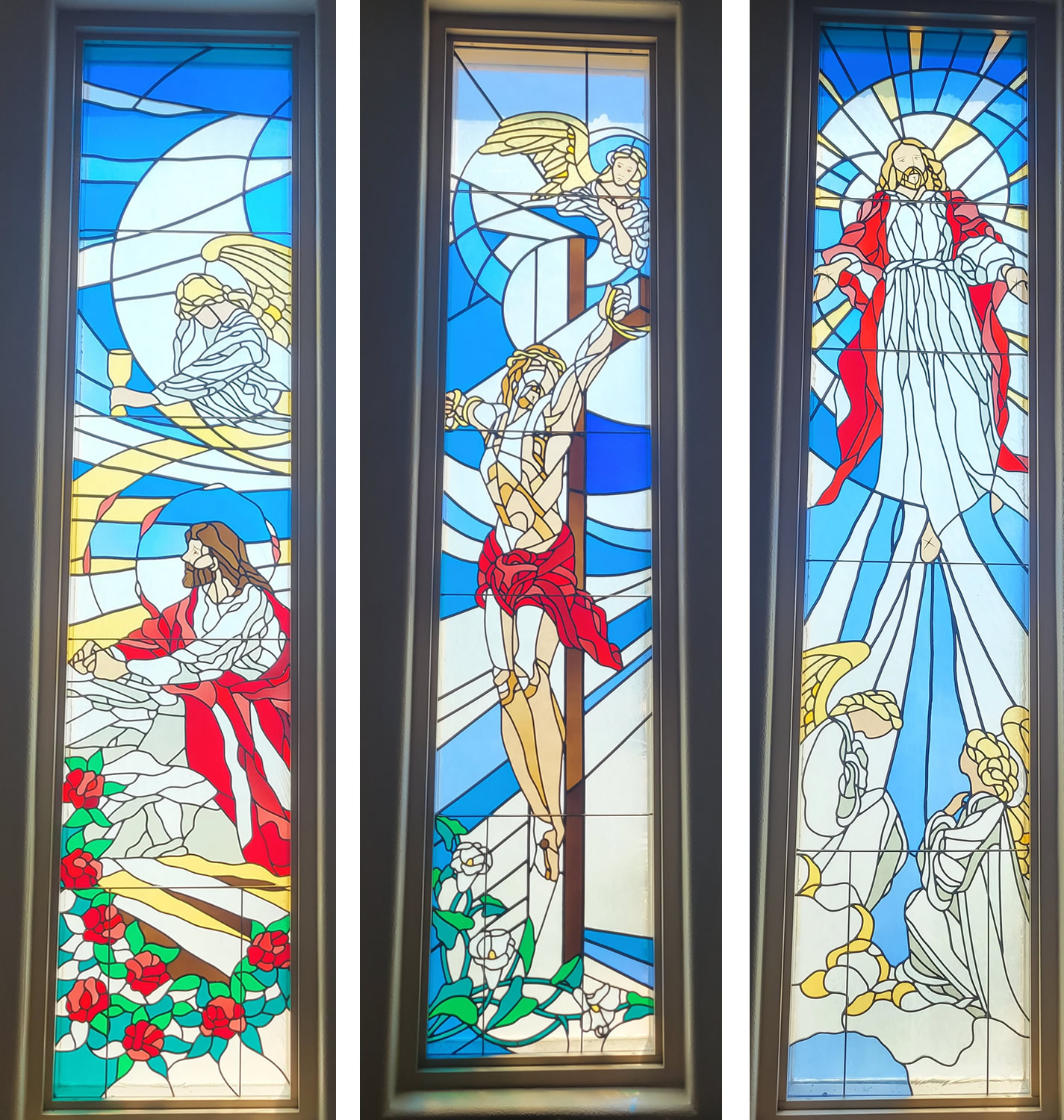
Agony in the Garden
After withdrawing about a stone’s throw from them and kneeling, he prayed, saying, “Father, if you are willing, take this cup away from me; still, not my will but yours be done.” And to strengthen him an angel from heaven appeared to him. He was in such agony, and he prayed so fervently that his sweat became like drops of blood falling on the ground. - Luke 22:41-44
Crucifixion of Our Lord
“No one has greater love than this, to lay down one’s life for one’s friends.” - John 15:13
Jesus cried out in a loud voice, “Father, into your hands I commend my spirit”; and when he had said this, he breathed his last. - Luke 23:46
Our Lord’s Glorious Ascension
“Go, therefore, and make disciples of all nations, baptizing them in the name of the Father, and of the Son, and of the holy Spirit, teaching them to observe all that I have commanded you. And behold, I am with you always, until the end of the age.” - Matthew 28:19-20